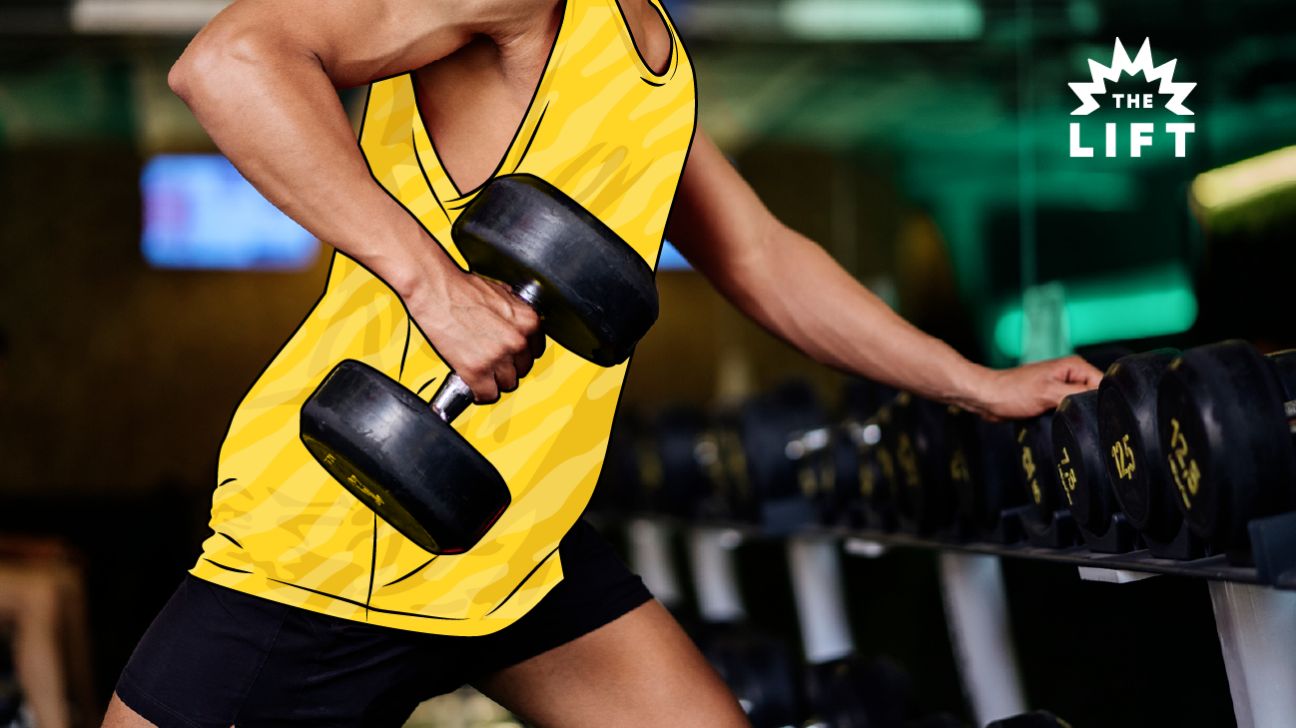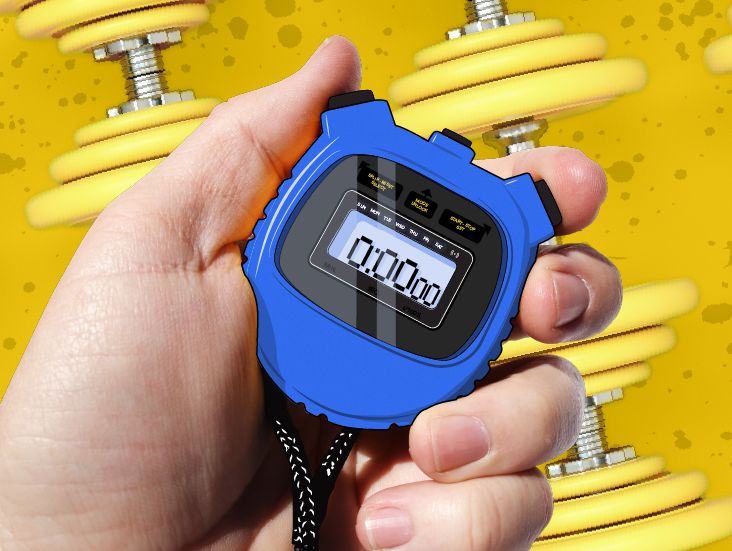Figuring out what pump cover and lifters to wear while strength training? Difficult!
Figuring how many fat stacks (weight plates) to slide onto your barbell or what weight dumbbell to sling around Ronnie-Coleman-style? Even more difficult!
That’s why we called up fitness experts and asked them how to know how much weight to lift, based on your specific strength goals. As for the first question? Welp, you’ll have to turn to FitTok.
The short answer
Exactly how much weight you should be lifting, and how often, is going to depend on a number of factors such as:
- fitness level
- health and fitness goals
- training age
- gym, weight, and transportation accessibility
- stress level
- hydration level and food intake
- recent sleep quality and quantity
But as a general rule, you want to lift only as much as you can lift with good form.
That may sound like a cop out, but it really is the golden rule of lifting. As physical therapist Grayson Wickham, DPT, CSCS, founder of digital movement platform Movement Vault puts it, “No matter your fitness goal you never want to be lifting so much, or in a way that causes more long- or short-term harm than good.”
There are more than three methods for determining how much to lift, but these are the most common.
Below, a breakdown of exactly what each methodology entails, as well as what type of strength athlete its most ideal for.
1. Progressive overload training
Progressive overload is a fitness principle that says in order to continue getting stronger, you have to continuously make your strength work more challenging.
How do you make it more challenging? Through a combination of:
- increased weight
- increased intensity
- increased number of sets
- reduced rest between sets
- altered tempo
This probably makes sense intuitively. But to understand why this is true physiologically, you first need to understand a bit about the musculoskeletal system.
Exercise physiologist Pete McCall, MS, CSCS, CPT, host of the All About Fitness Podcast explains, “Every time you challenge your muscles, little baby microtears are shorn into the muscle fibers. These damaged fibers repair. And on the other side of recovery are more resilient [stronger] than they were before.
In order for this process to continue to happen while you lift, you have to continue to challenge the fibers,” he says. “But because the fibers are now stronger than they were before, the same load isn’t going to be as challenging.”
In practice, that means that a 95-pound squat today isn’t going to feel as heavy as it did 3 weeks ago, assuming you were regularly squatting that load in your training.
The progressive overload principle basically says to the person who’s been lifting 95 pounds for 3 weeks, “OK, time to add some weight on that bar.”
Who should be using progressive overload training?
McCall says anyone who wants to get stronger should be applying the progressive overload principle to their workout routine in some way, shape, or form.
Wickham also recommends hiring a personal trainer who is able to write a progressive overload program specific to your needs and goals. Another option would be to join a CrossFit box that incorporates this principle into their training (most do).
2. Percentage-based programming
Percentage-based training is a specific, super-regimented style of progressive overload training, according to Wickham.
He explains, “You could alter those aforementioned factors (rest, sets, weight, intensity, tempo) at random and still get stronger — and technically would still qualify as progressive overload training!”
But percentage-based programming isn’t about that #RandomLyfe.
Percentage-based programming tells athletes to use specific percentages of their 1 rep max for specific rep and set schemes. “Typically, these percentage-based programs are 6 to 16-ish weeks long and involve doing the same lift at least 3 times a week,” says Wickham.
There are a ton of different percentage-based programs out there, especially now that Instagram fitfluencing is a thing.
But some of the most reputable strength programs include:
- Texas Method
- Madcow 5×5
- Wendler 5/3/1
Who should be using percentage-based training?
This style of training is best for experienced lifters who have a very specific strength goal.
For example, a weightlifter or powerlifter with an upcoming meet. “Any lifter who has the goal of hitting a specific amount of weight, needs to know exactly how much weight to use in training so that they can reach that goal during competition,” explains McCall.
Percentage-based training is also a good option for anyone looking for help structuring their sweat sessions.
And, the training’s helpful to athletes who divide the year into seasons according to their sport. For example, athletes have off-season, preseason, in-season, and postseason. During different seasons, athletes are suggested to adjust their training intensity with percentage-based training.
3. Based on feel
Lifting based on feel is a practice of lifting in order to achieve an intended feeling.
Exactly what that stimulus is will vary, based on the intent of your workout for the day. But typically, the goal will be fatigued at the end of your workout, according to McCall. “Fatigue is an indication that muscles have reached the limits of available energy,” he explains.
(FYI: McCall adds that this is different from failure, which suggests that the weight is too heavy for your muscles to lift, and will result in the weight falling to the floor or on the lifter.)
There are a bunch of different cues you or your coach might use to get you to the correct weight. For these cues, you could try to:
- Pick a weight you can comfortably squat 5 reps with. Then, rep it out to failure.
- Keep adding weight onto the bar until you arrive at a weight you could not do more than 2 reps at.
- Load up the barbell to a weight that will allow you to do 5 sets of 5 reps with 2 minutes rest in between, unbroken.
- Pick a weight that you can lift 4 times every minute on the minute for 20 minutes.
“What’s great about going by feel is you can still get a great workout without getting too caught up in the numbers,” says Wickham.
Who should be determining weight by feel?
The short answer: Everyone, at some point!
People who are new to strength training will not yet have a recorded 1 rep max, which is needed to officially implement progressive overload training and percentage-based training.
For these folks, Wickham recommends paying more attention to form and feel, than reaching a certain weight, percentage or intensity. “If you’re first starting, it can be beneficial to hire a personal trainer or physical therapist who can help you master form before adding weight,” he says.
Going by feel is also a good option for someone who isn’t able to lift as regularly as percentage-based training programs prescribe. (For more on this, check out the MisFit Podcast: Getting Stronger).
Wickham says going by feel sometimes is also a sign of an intentional athlete!
“Some days you walk into the gym on a day you’re supposed to lift X amount, but your body just isn’t feeling it,” he explains. Sure, sometimes you might choose to push past this feeling if it’s more emotional than physical. “But if you had a few crappy nights of sleep in a row, or a terribly stressful day at work, that is going to impact how much you can physically lift,” he says.
In some cases those outside-of-the-gym factors may actually make it physically impossible to hit the rep, set, or weight that’s programmed. And trying to lift it could lead to either injury or increased fatigue. “In some instances, it could tip your body toward overtraining syndrome,” says Wickham. Not ideal.
His suggestion: “If during warm-up you don’t even feel 80 percent of the athlete you typically are, listen to your body and decrease the weight, the reps, the number of sets, or increase rest substantially.”
Or, if you’re really in the hole, take a rest day!
If you have plans to make lifting a consistent part of your life for the next 20 to 50 years, taking a day off isn’t going to kill you. On the contrary, it could even help.
No doubt, figuring out how much to lift is not easy potatoes.
So, if you ever start to feel overwhelmed, take a second to give yourself a round of applause. Because “truly, there are so many benefits to lifting weights,” says Wickham.
“Most notably is the fact that [improving strength] can improve the overall quality of your life,” he says.
At the end of the day, there is no universal suggestion for how much weight to lift. But being aware of your current fitness level and personal fitness goals will help you find the right answer for you.






